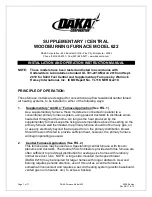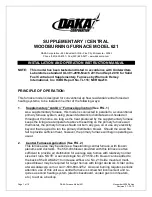
48
•
The IFC remains at the current firing rate until the 1st-
Stage call for heat is satisfied.
H
EATING
O
PERATION
WITH
CTK01 T
HERMOSTAT
(C
OMMUNI
-
CATING
)
•
When the Thermostat Heat Setup DIP switch is set to
2-Stage heat, the IFC operation will be compatible with
a CTK01communicating thermostat.
•
When a call for heat is sent, the furnace will go through
the Light Off Sequence, After the successful Light Off
Sequence and expiration of the Ignition Stabilization
Period:
•
The IFC adjusts to the low firing rate.
•
After 2 minutes, the IFC accepts the specific Heat
Requested Demand.
•
If the differential is equal to or less than 2 degrees, the
IFC will follow the conventional 2-Stage algorithm,
equivalent to a W1 request..
•
If the heat differential is greater than 2 degrees, the
IFC will follow the conventional 2-Stage algorithm,
equivalent to a W2 request.
•
The circulator will operate per the heat airflow profile.
H
EATING
O
PERATION
WITH
CTK02** T
HERMOSTAT
(M
ODU
LATING
C
OMMUNICATING
)
•
When the Thermostat Heat Setup DIP switch is set to
1-Stage heat, the IFC operation will be compatible with
a modulating communicating thermostat (CTK02**).
•
When a call for heat is sent, the furnace will go through
the Light Off Sequence, After the successful Light Off
Sequence and expiration of the Ignition Stabilization
Period:
•
The IFC adjusts to the low firing rate.
•
After 2 minutes, the IFC accepts the specific Heat
Requested Demand.
•
If the differential is 2 degrees or less, the Heat Current
Demand Status will show 50%.
•
If the specific Heat Requested Demand is above 2 de-
grees, the Heat Current Demand Status will track the
specific Heat Requested Demand.
•
The circulator will operate per the heat airflow profile.
H
EAT
A
NTICIPATOR
S
ETTING
The heat anticipator in the room thermostat must be correctly
adjusted to obtain the proper number of cycles per hour and to
prevent “overshooting” of the setting. Set the heat anticipator
setting to 0.7 amps. Follow the thermostat manufacturer’s in-
structions on how to adjust the heat anticipator setting.
D
RAIN
T
RAP
P
RIMING
The drain trap must be primed prior to furnace startup. To prime,
fill the drain trap with water. This ensures proper furnace drainage
upon startup and prohibits the possibility of flue gases escaping
through the drain system. Air conditioning condensate may be
drained into the furnace trap. Please see requirements in
Condensate Drain Lines & Drain Trap
section.
MIN.
50%
60%
(80%)
70%
IGNITION
10 MINS.
8 MINS.
2 MINS.
90%
Operation with Conventional 2-Stage Thermostat
(DIP switch selects 2-stage heat)
Call for 2nd-Stage Heat - Thermostat contacts close R to W1
and W2.
After a successful Light Off Sequence and expiration of the
Ignition Stabilization Period:
•
The IFC adjusts to the low firing rate.
•
After 2 minutes, the IFC increases to 80%.
•
Thereafter, the IFC will increase 10%, at a rate of 1%
per second, every 10 minutes for the remainder of the
call for heat.
•
The circulator is adjusted to the appropriate CFM, cor-
responding to the current firing rate.
O
P
E
R
A
T
I
O
N
MIN.
50%
78%
(80%)
100%
IGNITION
2 MINS.
CALL FOR
2ND STAGE HEAT
UNIT CALL FOR HEAT ENDS
Call for 2nd-Stage Heat with 1st-Stage call for heat call in
progress, with conventional 2-Stage Thermostat.
•
The IFC increases the firing rate to 100% at a rate of
1% per second for the remainder of the W2 call.
•
The circulator is adjusted to the appropriate CFM, cor-
responding to the current firing rate.
Call for 2nd-Stage Heat satisfied; Call for 1st-Stage Heat re-
mains.
OPERATION
















































